Content
- 1 What greens can be grown on the windowsill
- 2 What greens can be grown on a windowsill in winter
- 3 How to properly grow greens on a windowsill
- 4 Video "How to grow greens on your windowsill"
- 5 What greens can you grow at home?
- 6 General rules for growing greens
- 7 How to grow parsley?
- 8 Growing spinach and onions
- 9 Growing lettuce and dill
- 10 What can be grown at home?
- 11 Kitchen garden on the windowsill
- 12 How to properly grow greens on the balcony
- 13 Caring for greens at home
- 14 Greens for sale
- 15 Conclusion
All housewives sooner or later begin to understand how nice it would be to have a bunch of fresh herbs always at hand. Whether it's winter or summer, it doesn't matter. Greenery on the windowsill all year round is not a myth! To fulfill this desire, it is not at all necessary to have a magic wand, just a packet of soil, seeds and patience will be enough.
What greens can be grown on the windowsill
Green onions
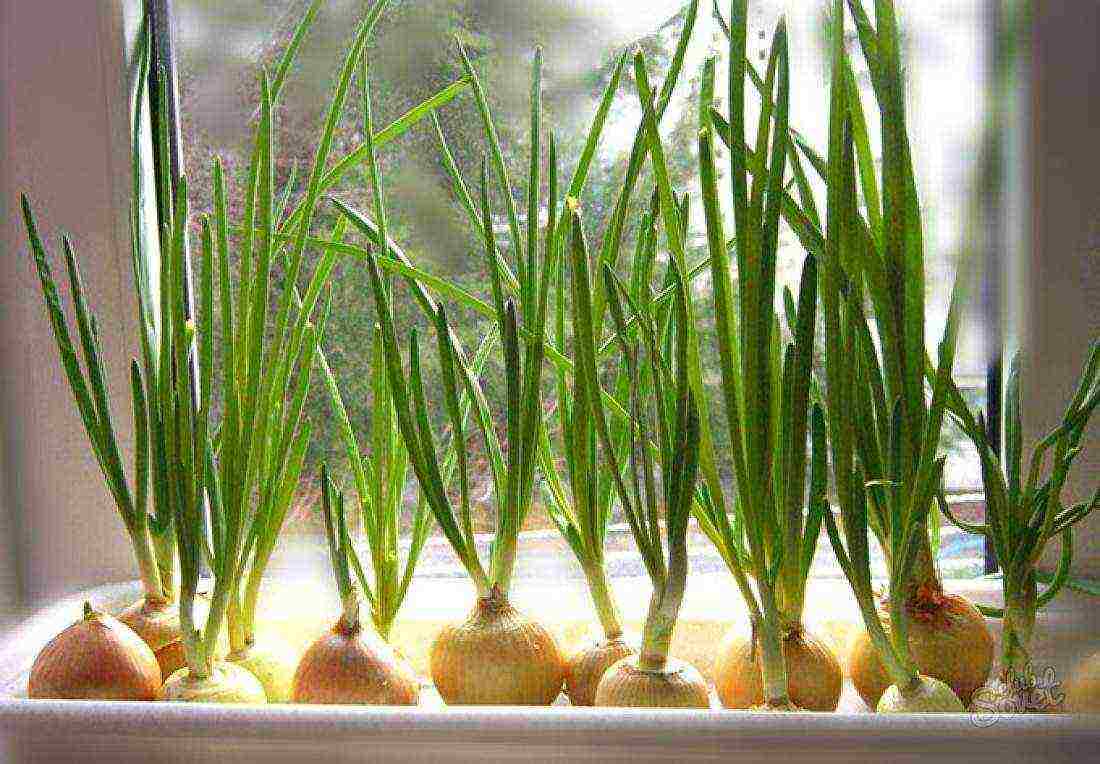
This is ideal for a vegetable garden on a windowsill. Planting material can be both onion sets (small onion bulbs for seedlings) and turnip onions (already adult fruits).
Sevok takes longer to germinate and yield less. But the feather tastes better and softer. Green bunches can be cut from the turnip in a week. However, the set takes much less space on the windowsill.
A turnip can be grown in two ways - in water and in soil.
1. Growing in water.

This requires a small container of water. At the turnip, carefully cut off the top and bottom. Place the onion from top to bottom so that it slightly touches the water.
The disadvantage of this method is that after a while, the bulb begins to rot and give off a characteristic odor.
2. Growing in soil.
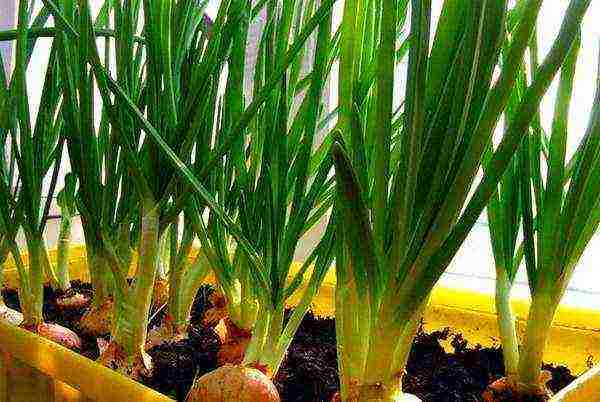
We fill up the soil in a small container and plant a turnip or sevok in it. We pour water and wait for the first green feathers.
A hydrogel pre-soaked in water can be placed on the bottom of the container. Thus, you will save the plant from drying out.
Dill

Growing dill on a windowsill is not easy. And not every housewife can grow dill on a windowsill in winter, because in the cold season, seeds germinate for a long time and with great difficulty. The best option would be to buy dill seedlings and plant them in pots.
But if you are firmly decided to grow a fragrant plant from seeds on your own, then you need to sow the soil in steps, to sow in small portions in a month. So you can provide yourself with greenery on the windowsill all year round.
Seeds are best placed in the ground to a depth of 1-2 cm.When seedlings appear, you need to carefully thin them out, leaving a gap of 2-3 cm between the shoots. You should also ensure abundant watering. And if there is dry air in the room, it is necessary to additionally spray the greens, otherwise the leaves will become coarse. Mineral fertilizers should be used as top dressing.
Parsley

Seed parsley sprouts rather slowly, so be patient. The plant is light-requiring, this must be taken into account when choosing a location for greenery. At the same time, parsley calmly reacts to temperature changes, and feels comfortable on a cold windowsill.When watering, it does not require special treatment.
To increase the likelihood of seed germination, you need to soak them for a day in water or a weak solution of potassium permanganate (about 0.2%). After that, wrap them in cheesecloth until white sprouts appear.
How to grow parsley on a windowsill in winter?
Since there is a shortage of sunlight during the cold period, the problem of how to grow parsley on the windowsill is solved by choosing the sunniest location for the future green bed. You can also eliminate the lack of light by illuminating the plant with a special phytolamp.
Do not forget about fertilizing with mineral fertilizers.
Cilantro

This spice plant loves fertile soil, but does not impose special temperature requirements. Therefore, with a responsible approach to the choice of soil and feeding, the question of how to grow cilantro on the windowsill can be considered closed.
The plant belongs to the category of early ripening, so you won't have to wait long for the harvest. However, special attention should be paid to watering - do not let the coriander (this is another name for the plant) dry out.
Basil
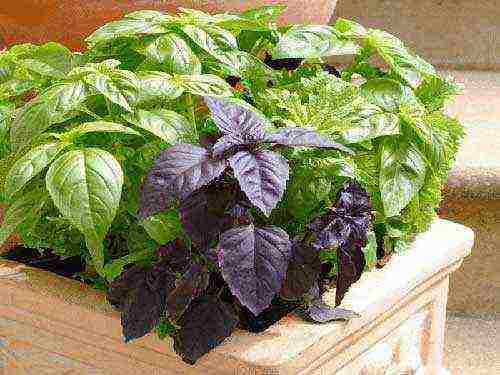
This is a sun-loving and unpretentious plant. After sowing the soil, water it and cover it with cling film until shoots appear.
Also, these greens can be grown from a freshly cut stem. You need to place the stem in water and wait for the roots to appear. Then it must be planted in the ground.
It is important!
In order for the basil to bush and grow in breadth, and not in height, after the appearance of 5-6 leaves, it is necessary to cut off the top. When buds appear, they should be removed as the plant will produce flowers, not leaves.
What greens can be grown on a windowsill in winter
First of all, these are early ripening plants: watercress, coriander, mustard, as well as everyone's favorite leek.
Green leaves are a real storehouse of vitamins. They will help fill the deficiency of nutrients and nutrients in the body, tired of winter beriberi. They also diversify the home menu and decorate any dish with their presence on the plate.
Helpful information
In order to have homemade greens at hand all year round, it is necessary to finish sowing the beds with seeds about once a month, creating a so-called "green conveyor".
How to properly grow greens on a windowsill
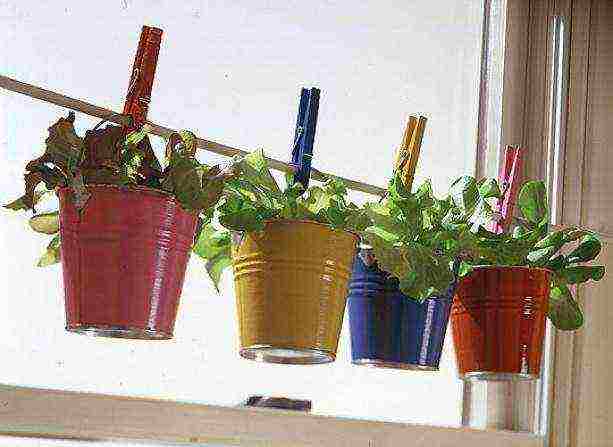
Despite the fundamental difference between plants and their needs, there are rules that apply to all potential tenants on your windowsill.
• Lighting... The winter period is characterized by a lack of light, so the plants need additional lighting. Special phytolamps will help to fill the deficit. It is best to connect a timer to such a lamp - so the backlight will turn on automatically for the required amount of time and you will not have to constantly monitor it.
• Priming... To grow plants in winter, you will need a soil mixture that contains fertilizers and has already been cleared of debris. Also, a drainage layer must be laid at the bottom of the pot - it will save the roots from decay and prevent moisture from accumulating at the bottom of the box. Drainage can be bought in a store or you can use improvised means - breaking bricks, pebbles, crumbled foam.
• Seeds and seedlings... The need to buy special seeds for growing at home is not necessary - ordinary "garden" seeds feel great on the windowsill. If you are a novice gardener, you can buy herbs in containers, already with roots, instead of seeds. You just need to transplant and care for the plants.
Also, a great helper for plant breeders is a hydrogel - a substance that contains nutrients and swells, absorbing water. The hydrogel is laid on the bottom of the flower pot in a swollen state. With the help of it, you will protect your plants from drying out (the hydrogel will give up its water) and from excess moisture (the substance will absorb the excess).
Soil is not the only medium for growing greenery.There is one more, rather unconventional method.
An unusual way of growing greens
We take a thin layer of sterile cotton wool and place it on the bottom of the container. Moisten with boiled warm water (temperature 30-35 ̊С) and drain off the excess. We sow and close the container on top with glass or polyethylene. We place crops in a warm place. This creates a moist chamber with the most favorable conditions for seed germination.
The first shoots will delight you in 5-7 days.
Now you know that it is not difficult to take care of the green bed on the windowsill, it is enough to follow simple rules and adhere to the required watering regime for the plants. Then your mini-garden will delight you with a tasty and healthy harvest all year round!
Video "How to grow greens on your windowsill"

Growing greenery on a windowsill in winter for beginners is a very real task. You just need to create suitable conditions for it and choose those types of it that will feel good even indoors. A mini-vegetable garden on the windowsill today is not only a practical, but also a fashionable solution within the framework of the current eco-trend and the promotion of a healthy lifestyle. Of course, it is very convenient to always have fresh parsley on hand, but at the same time such a garden not only provides the family with fresh herbs and vitamins, but also becomes a decoration of the kitchen.
What greens can you grow at home?
Greenery on the windowsill all year round is not the most difficult task. Of course, each gardener decides for himself which crops will make up this vegetable garden on the window. But you need to take into account the peculiarities of growing one or another greenery at home. The purpose of their breeding is to obtain a high yield, and you need to choose those varieties that ripen quickly.
In most cases, greens at home are grown from seeds. But, of course, it all depends on the culture itself. So, green onions are grown from a bulb. This is generally one of the most common garden crops that grow on windowsills. On the one hand, it is very easy to grow, on the other hand, it is a whole storehouse of vitamins. Many housewives are afraid to grow it because of the unpleasant smell, but it only occurs when the bulbs are kept in water for too long. And if it is grown in the ground, then there will be no smell.
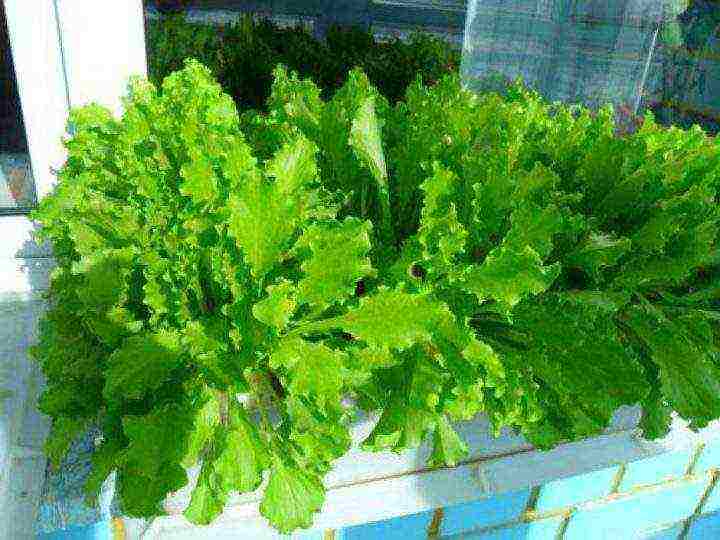
Leaf salad
A home garden on the window often includes spinach. This is one of the most common types of greenery, as it sprouts quickly and looks beautiful in a pot or neat box.
Dill can also be grown on the windowsill, but only some of its varieties, since it ripens quite late, even in the best case, its first sprouts will appear only a month after sowing.
And, of course, the window garden includes parsley. Unlike other types of greens, it is grown from root vegetables, in which the whole upper bud must be preserved. Dill is grown in fairly tall pots or boxes. But most types of salad do not require this. In addition, it is recommended to use peat tablets or cassettes for them. Experts advise buying several types of lettuce, with leaves of different shapes and colors. Firstly, the plants will look more decorative, and secondly, the greenery on the windowsill will be all year round, since different species differ in terms of ripening. The most unpretentious type is watercress. It does not grow so luxuriantly, but because of the characteristic shape of its small leaves, the pot of greenery seems curly.
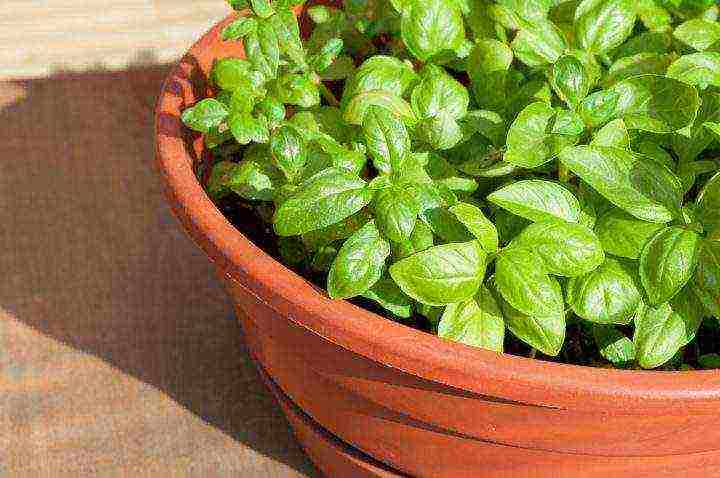
Growing basil
In theory, a window garden could include more crops. But not all of them will grow in winter lighting conditions. And some for normal development need a stable above-zero temperature outside the window. This applies to crops such as arugula. basil, watercress, marjoram and thyme.To make the seeds of these crops sprout faster, they arrange something like a mini-greenhouse, covering the pots with a film, under which there will be a comfortable temperature and humidity for these species.
General rules for growing greens
The garden on the window is not difficult at all, the main thing is to follow the general recommendations. You can grow greens in ordinary flower pots, and in wooden boxes, which should not only be convenient, but also beautiful. In addition, the drawers should be made in such a way as to keep out water. It is very important to choose the right pot parameters. The optimal length of the container for most types of greenery is 40-50 cm. The width should be 20-25 cm, and the height should be 12-15 cm. A drainage hole must be made the day before. In such a pot or container, a drainage layer must be arranged. To do this, use expanded clay, broken brick or even just coarse clean sand.
It is not enough to know how to grow greens at home, you also need to be able to find the optimal place for it. As a rule, greens prefer warmth and sunlight, so it is better to grow them in a south or southwest window.
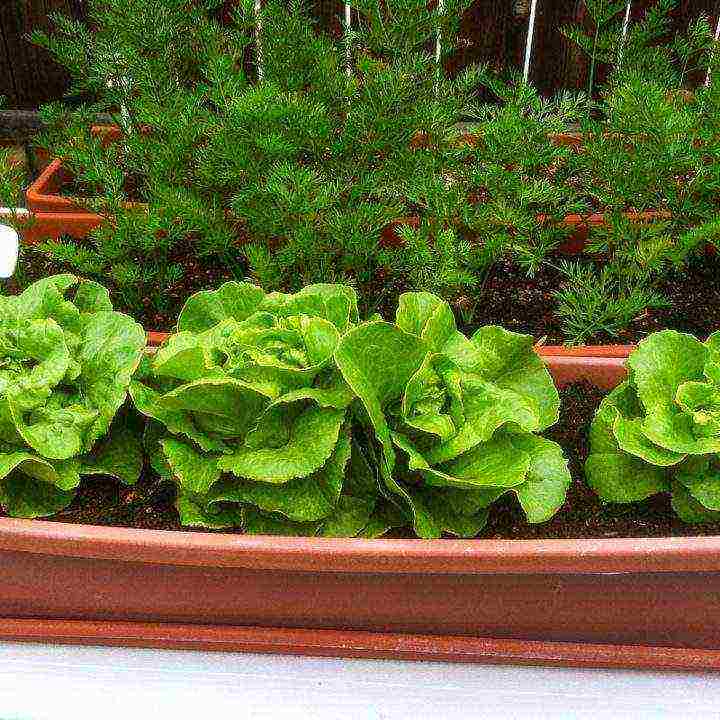
Kitchen garden on the windowsill
Before planting, it is imperative to water the soil prepared for distillation with hot water, then crush it and make grooves in it: then seeds are poured into them, and a layer of earth about a centimeter thick is added on top.
Greens are usually watered every other day, usually in two doses and in small portions. It is recommended to warm some seeds before planting and first germinate in damp gauze. But this mainly applies to crops such as asparagus.
Growing greenery at home means creating the most comfortable conditions for it. For example, most of these crops are harmed by dry heat from radiators. In order not to harm the plants, the battery can be covered with a special shield and a humidifier can be used. This is also useful for creating a comfortable microclimate in scrap. If it is not possible to buy such a device separately, you can make an impromptu humidifier by simply putting a piece of wet cloth on the battery.
In winter, greenery lacks light. Therefore, many plants grow pale, and there may be less vitamins in them. In such cases, additional illumination using ultraviolet lamps is used. For most crops, the optimal daylight hours are 12-16 hours.
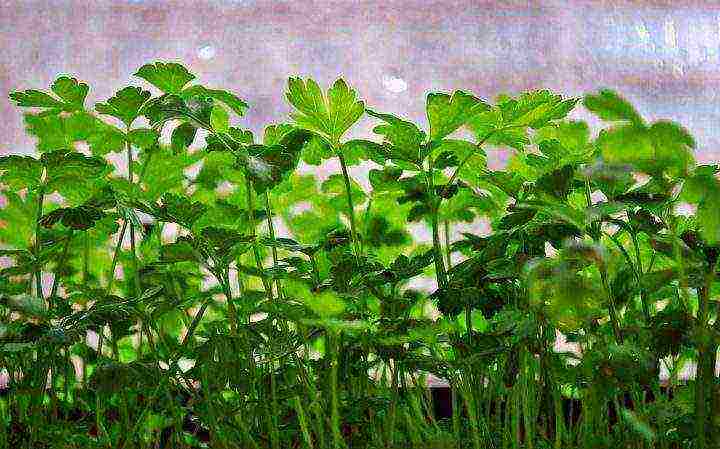
Lovage
However, pale leaves can mean chlorosis, which often occurs due to problems in the acidity of the water. The fact is that tap water is often a more alkaline medium, and therefore a number of nutrients (phosphorus, manganese, iron, boron) cease to dissolve in the soil, plants do not receive them, and this affects their condition. In this case, you need to take care of the water for irrigation; in extreme cases, you will need to add special phyto-mixtures to it.
With home-grown crops, you can safely replenish your diet. Firstly, in this case it is known for sure that all this was grown without chemistry. Secondly, greens that were picked and used almost immediately retain more vitamins than those that have been in the store for a long time.
How to grow parsley?
As you know, parsley is a real storehouse of vitamins. The composition of this plant includes ascorbic acid and vitamins A and E, which are antioxidants, and B vitamins, and phosphorus, and potassium. Of course, every housewife wants such greens to be always at hand. Parsley is easy to grow, but remember that its seeds take much longer to germinate than other green crops due to their high content of essential oils. There are two options for growing it: from a root crop and by accelerating seed germination. When choosing the second option, the seeds must be thoroughly rinsed with water and wrapped in a damp cloth.
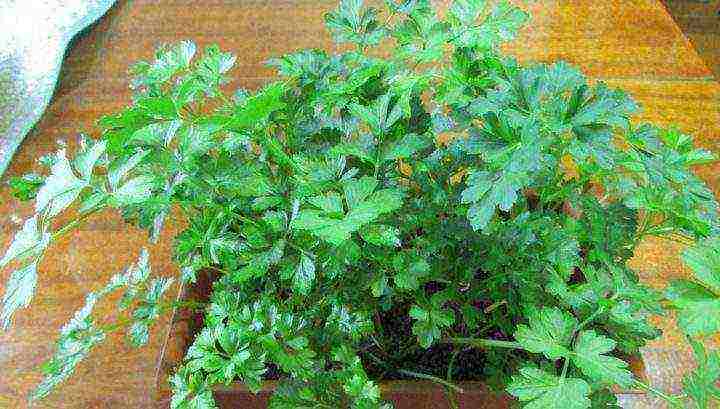
Growing parsley
The soil for growing parsley is prepared in advance. You can take ordinary garden soil, but it will need to be additionally treated with a weak solution of potassium permanganate for disinfection. You can buy ready-made soil for such crops, which is sold in garden centers.
There should be no difficulties with growing parsley. You just need to take the container a little higher than usually taken for greenery - 20 cm high. A drainage layer is placed at the bottom of the container, then covered with earth. After the soil is ready, you can plant the seeds. To do this, make beds with a distance of 10 cm from each other. Seeds are planted to a depth of no more than 1 cm. The soil is watered before planting, as described above. In the future, until shoots appear, the earth is watered every other day from a sprayer. After the emergence of seedlings, you can already water from a watering can once every two days.
At a temperature of 20 ° C and normal illumination, parsley shoots will appear in 3 weeks.
Growing spinach and onions
Spinach can be grown on the windowsill all year round. This culture has a taproot, which requires compliance with certain rules regarding the selection of pots for it. When caring for plants, it is important not to flood the soil and avoid contact of delicate leaves with water when watering.
Spinach is germinated in boxes or containers at least 10 cm high. Good drainage is very important for it. For this, expanded clay is usually used. Spinach seeds are planted not tightly, but at a distance of 5-10 cm between the rows. Planting depth - 1-2 cm.Under favorable conditions, greens suitable for consumption will appear in 1-1.5 months. The most delicious is the greens obtained from plants with 6-10 true leaves.
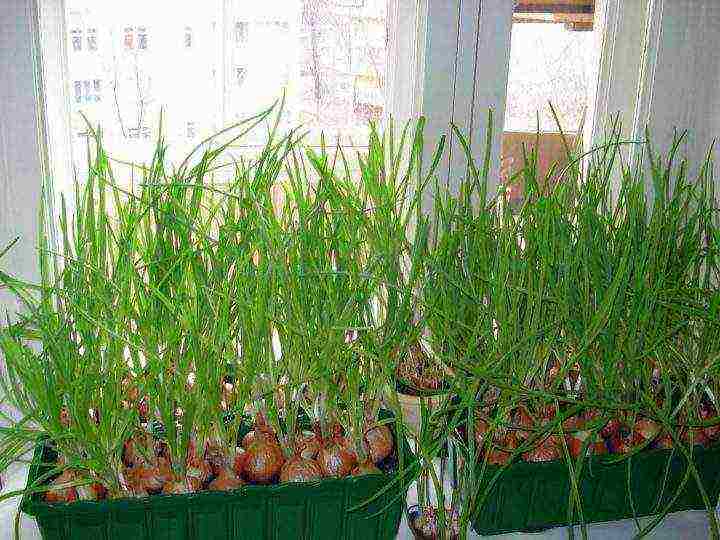
Growing onions
You can choose any onion for planting. The larger the bulbs, the more nutrients they will contain and the more greenery will be grown. But you can also plant small shallots. The ideal option is to choose several varieties at once with different dormancy periods so that the greens are on the table all year round.
In theory, onions can also be grown from seeds. But in this case, it should be clarified whether this or that variety can be grown at home.
Growing lettuce and dill
Lettuce greens are tasty and healthy. And there shouldn't be any problems with growing it. However, it must be taken into account that this culture has very small seeds, therefore, later, when shoots appear and the feeding area increases, a pick will need to be made. For these purposes, cassettes are used in which you need to plant seedlings - they choose those that already have 1-2 real leaves with a lump of earth, and one in each cell. Over time, the salad will grow beautifully.
As for dill, not all varieties are suitable for growing on a windowsill. For mini-vegetable gardens, the variety "Grenadier" with light leaves and a delicate aroma and taste, the unpretentious and disease-resistant variety "Gribovsky", the very fragrant variety "Richelieu" with beautiful blue-green leaves resembling lace, as well as the variety "Kibray" containing a huge amount of vitamins.
As with any greenery, you need to prepare the soil to grow dill. The garden soil is disinfected, and this is the most important moment for further harvesting. To do this, it is recommended to treat it with a solution of potassium permanganate, and if it is not there, then ignite it in the oven or microwave. Another option is to treat with hot steam, which is guaranteed to eliminate pests.
A drainage layer is placed at the bottom of the container, then the prepared soil is poured. The seeds are pre-soaked in warm water and left in this state for a day, changing the water every 5-6 hours. Then they are dried with a paper towel or cloth and planted in a pot.
Dill is sown in beds, seeds are sown to a shallow depth, and covered with a layer of earth about 2 cm thick on top.This crop requires abundant lighting, so it is usually grown under ultraviolet lamps.
It should be remembered that greenery has a short growing season. Therefore, it has the ability to quickly accumulate nitrates in large quantities. This makes any feeding problematic, including with the help of mineral fertilizers. The soil sold in garden centers contains enough minerals. But if in doubt, you can feed the greens with natural fertilizers, in this case, eggshells and tea.
Not everyone has a summer residence, but every family needs fresh parsley, dill, and green onion feathers. The solution is simple: growing greenery on the balcony or on the windowsill will allow you to have vitamin seasonings all year round. Some housewives tried this method and refused, because the herbs turned out to be tasteless and not aromatic. The reason is improper care: in winter there is little light in the apartment, the air is too dry and other unfavorable conditions that must be taken into account when growing vegetables at home.
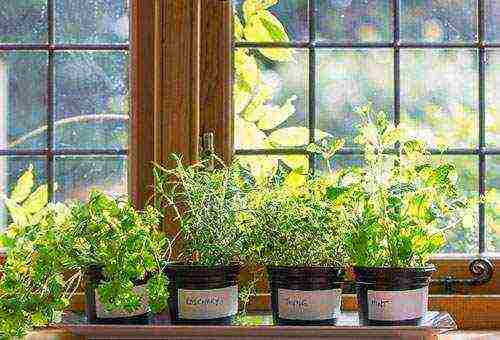
What can be grown at home?
Many herbs can grow in a small amount of soil, so they can be grown in containers, boxes, and windowsill pots.
Suitable for growing at home:
- Dill;
- mustard leaf;
- parsley;
- green onions;
- watercress;
- celery;
- basil;
- leaf salad;
- coriander.
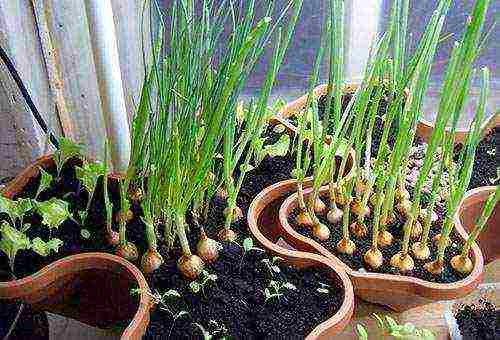
You can start creating your home garden with green onions. It does not need soil - take a jar with a narrow neck, fill it with water and set the bulb so that its edges rest on the sides of the container, and the roots are immersed in the liquid. You only need to change the water from time to time and cut the green shoots for food. When the bulb shrivels and becomes soft, the growth of the shoots is over, replace it with a fresh one.
It is easier to grow each species in a separate container, so you can choose the right soil composition, provide the necessary conditions and watering. In addition, a large, heavy box is difficult to move, turn towards the light so that the plantings are evenly lit. In small pots and containers, you can separately grow each species and variety, in good weather, take them out to the balcony, and if there is a threat of frost, bring them indoors. For proper moistening, it is necessary that there are drainage holes in the bottom. It is easy to select a pallet for a compact container, and excess liquid will not create puddles on the windowsill.
Advice
When you have little space or containers, you have to grow different types of greens in the same container. Group plants according to their thermophilicity: dill, watercress, celery and parsley in one container; in the other - thyme, marjoram, basil.
Be sure to allocate at least one container for the children. Let them decide what herbs will grow there, sow seeds with you, take care of their plantings on their own. Even a first grader can do such work. Explain that the plants are alive, they can die of thirst, and the child will have responsibility for their pets.
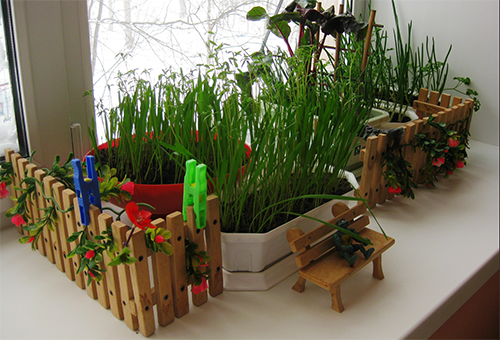
Kitchen garden on the windowsill
You need to start work with the preparation of the necessary equipment and materials. Containers should have drainage holes. To prevent excess moisture from accumulating on the windowsill, place containers on pallets. In winter, the air in apartments is often too dry. Add hydrogel to the soil, it will provide the roots with moisture if you forget to water the plantings in time. Put small pebbles on a pallet and regularly moisten the stones, then the plants will not suffer from dryness at home.
Each crop requires a different approach when planting and growing.
- Green onions can be grown both in water and in the ground. Take a set or small onion bulbs and plant them in the ground 2 cm apart, burying them halfway into the ground.
- For a feather, you can plant perennial onions in boxes. Dig it up in your garden, cut off the green feathers, and plant it in a container.
- Parsley seeds germinate slowly due to the abundance of essential oils. Soak the grains for a day in a saucer of water, and then sow. You can plant rhizomes with a good apical bud in the ground, place long roots obliquely.
- Sow watercress in rows at 10 cm intervals.
- Lettuce seeds should be sown in separate grooves so that the distance between the plants is about 5 cm.You can sprinkle a few grains in each hole, and then leave the strongest specimens.
Advice
At home, vegetables are usually grown, for which the aerial part is used for food. To help the shoots and leaves develop well, sow herbs when the moon is growing. If you need good rhizomes, start sowing when the night star is in a waning phase.
Pour expanded clay at the bottom of the container, then the nutrient mixture. It can be purchased at the store or prepared from the same amount of peat, sawdust and sand. After sowing, sprinkle the seeds with a layer of soil 0.5 cm thick, cover the container with foil and keep in a warm, dark place until shoots appear. To keep the green conveyor constantly supplying you with fresh seasoning, plant a new plant every 2 weeks.

How to properly grow greens on the balcony
Those who do not have a summer cottage can grow greens on an open balcony in the summer. If you build deep boxes, you can sow other crops: radishes, carrots, cucumbers, tomatoes. In summer, caring for plantings in boxes is not much different from cultivating herbs in the open field, the only difference is that the earth dries out quickly, and watering should be more frequent. Frost-resistant species can be sown as soon as warm days come, and basil, rosemary and other southern crops are kept at home on the windowsill and taken out into the street only when the spring frosts end.
In winter, greens can be grown on glazed and well-insulated loggias. Try to plant unpretentious species that will withstand a short sharp cold snap. Don't forget about lighting, equip your balcony with comfortable fluorescent lamps. If stationary boxes are used for planting, which cannot be brought into the room in severe frosts, keep heaters ready.
Residents of the southern regions can grow on glazed loggias and heat-loving crops: basil, rosemary. You need to plant greens only in small containers, which, if the weather forecast is unfavorable, can be easily brought into a warm room. It is desirable that all bindings are with sashes. Winter in the South is unpredictable, even in January the temperature can rise to + 20⁰. On warm, clear days, open the windows to let the plants enjoy the sun and fresh air.

Caring for greens at home
In the northern regions in winter, plantings do not have enough light, so often the greenery on the windowsill grows tasteless and without aroma. The plants themselves will tell you that it is too dark for them: they will begin to stretch upward. Install energy-saving lamps and give your pets a day of at least 12 hours. To take full advantage of the brightness of the light, surround the containers with mirrors or foil.
The next problem is overcrowding. Each bush should have enough room to grow. If, when sowing, you poured the seeds too thickly, destroy the excess copies. When plants are spacious, they will produce more tasty succulent shoots and leaves. If you notice that buds appear on the plantings, cut the peduncles, and the greens will be lush and softer.
Plants need sufficient watering for good development. In very dry apartments, be sure to add hydrogel to the soil, and cover the soil surface between the plants with small pebbles. Water at least every other day and spray the herbs with a spray bottle. If the soil starts to crust over, loosen it up. Every 2 weeks, feed your garden on the windowsill with a compound fertilizer solution.

Greens for sale
If the area of the apartment allows, cultivating greenery at home on the windowsill can be a good addition to the family budget. There are many techniques for organizing your herb business. If you wish, you can build racks in several tiers or purchase a hydroponic plant. There are entrepreneurs who have earned their start-up capital from parsley and dill. To be able to promote your business, you need commercial ability, and an ordinary housewife can simply sell surplus greenery.
It is not necessary to stand in the market, you can get acquainted with the seller of herbs and give the greens for sale. Another option is to offer your products to a small cafe or diner. The owners of small establishments are already tired of imported herbs, which are expensive, look good, but cannot boast of any taste. They will gladly acquire spicy bunches from you, which grew half an hour ago in the fertile soil on your windowsill and absorbed the aromas familiar from childhood.
The easiest way is to post a notice on your front door. In an apartment building, neighbors will instantly buy up all the surplus from you and will be registered in the queue for the next harvest. If you are on maternity leave, freelancing, or for some other reason do not have a steady income, the containers on the windowsill will help to replenish the budget.
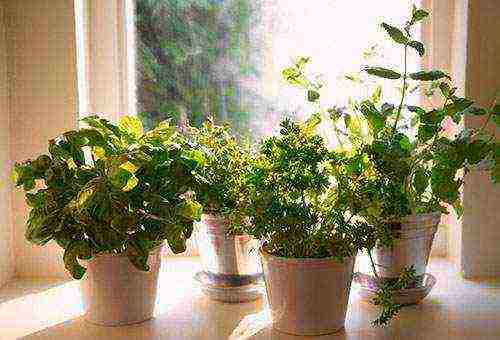
Conclusion
Fresh greens can be grown at home all year round. In summer, a summer cottage or balcony will supply you with vitamins, and in winter you can grow herbs in a heated greenhouse, on a glassed-in loggia, or right in a room on a windowsill. You will get a double benefit: a harvest of juicy leaves, and a natural humidifier of dry air in the apartment.
It is advisable to grow each species in a separate container. If there are few containers, group the plants so that the same box contains herbs that require the same growing conditions and ripen at the same time. Prepare a pot with new seeds in advance, then fresh herbs will be present on the table without interruption. Remember that rhizomes planted for distillation are quickly depleted, after about 2 harvests they will have to be changed to new ones.
In order for greens to gain taste and aroma at home, they need a lot of light. Install energy-saving lamps and reflective screens and keep the stems from pulling out. Water and loosen the soil in time, don't forget to feed your pets, and you will never have to stop at the stalls with withered parsley and dill, which looks more like a camel thorn.
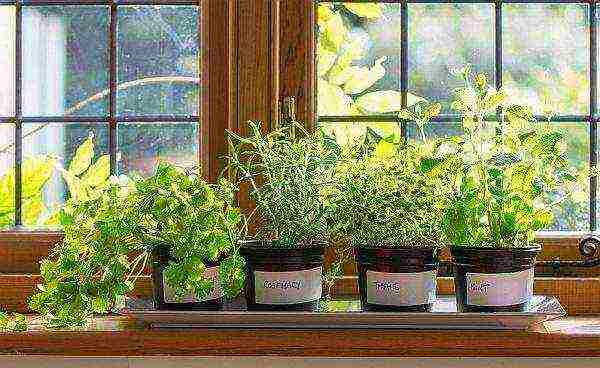
When planning to master the cultivation of greenery on the windowsill in winter, autumn and spring, lovers of indoor beds consider three indisputable leaders: dill, parsley and green onions.
These plants are suitable as a condiment for many dishes. They gained their popularity due to their ease of care, versatility and taste. How to grow popular and not very well-worn spicy herbs in the kitchen with your own hands, what to look for in order for the crop to please the eye and taste?
- General recommendations for growing herbs on a windowsill
- Requirements of different greenery
- How to grow parsley on the window
- Features of growing dill in an apartment
- Fragrant basil on the window
- Ideal salad variety for home growing
- How to get green onions quickly in winter
- Fragrant mint in the home kitchen
- What else can be grown on a windowsill in an apartment
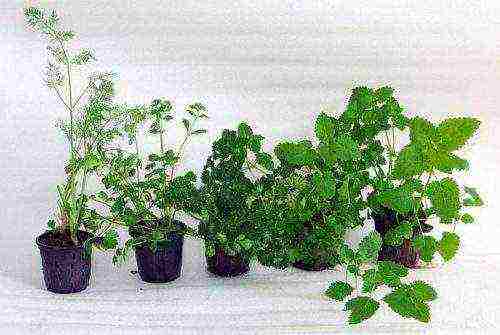
General recommendations for growing herbs on the windowsill
Almost any greenery can be grown on the windowsill in the apartment. The main thing is to choose the right variety and comply with the plant's requirements for soil composition, air humidity, watering, and temperature conditions.
Important:
- Choose unpretentious varieties, or better hybrids specially bred for indoor conditions. This will make it easier to care for and increase the chances of a crop.If you are not confident in your abilities and want to get a quick result, buy not seeds, but ready-made seedlings in pots.
- Practical greenery pots on the windowsill should be rectangular. Take a wide and shallow dish. Plastic containers are quite suitable, they are lightweight and practical to clean. Ideal for multiple use. Read more about the choice of containers here.
- Buy a light, well-drained soil for your greenery. You can prepare a mixture of vermicompost with coconut fiber. The proportion should be 1: 2. At the bottom of the pot, be sure to pour a layer of small stones, expanded clay, crushed foam, or make another drainage.
- If the window is cool or blowing, use plastic hoods to create mini greenhouses. You can buy ready-made or do it yourself from a package.
- The optimal daylight hours for green pets are 10-13 hours. In winter, there is not enough light, especially on the north side. To illuminate the greenery on the windowsill, install lamps, it is better to buy fluorescent or special phytolamps. Regular fixtures will not work.

- Do not neglect top dressing, pick up complexes of mineral fertilizers for watering every 2-3 weeks. But make the solution less concentrated than for open ground.
- Spray green pets every other day or more with a fine spray, especially if the air in the apartment is dry.
- Do not be lazy to turn the pots in different directions to the light so that the plant develops evenly.
- To grow greenery to the apartment, it is better to take a window sill in the kitchen. The bedroom is not the best place for frequent watering, spraying, and fertilizing. In the bathroom, herbs will look ridiculous, other plants are more appropriate for landscaping.
If you do not want to be limited only to greenery, then study our tips for organizing and decorating a vegetable garden on the windowsill and find out what else you can grow in a city apartment all year round. However, for beginners, it is best start with herbs and indoor pepper. Difficult to cultivate plants can disappoint with the result and discourage the process.
Requirements of different greenery
Before heading to the store for seeds or seedlings, learn how to grow different types of greens on the windowsill, and stop at the simplest and most affordable option for you.
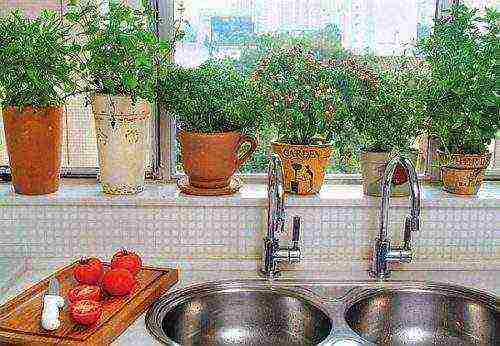
How to grow parsley on the window
To grow parsley in pots, you need a mixture of one part of peat, the same amount of humus and twice the volume of garden soil, disinfected with a solution of potassium permanganate. But it's easier to buy a ready-made universal primer.
When choosing seeds, give preference to early, fast-maturing varieties. This information is indicated on the packaging. Low-grade species and curly parsley look beautiful. It is important that the selected variety can easily tolerate frequent pruning, because you will constantly pluck the leaves to decorate dishes.
Optimal varieties for indoor conditions:
- Appetizing;
- Vorozheya;
- Aster;
- Gloria;
- Nastenka;
- Station wagon;
- Russian feast.
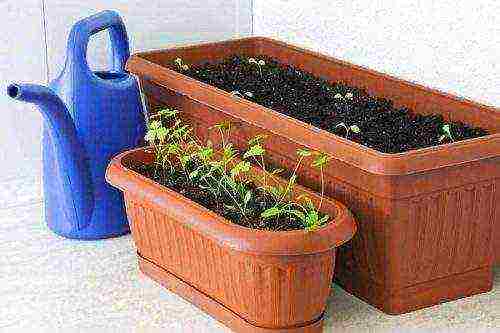
To increase the germination of parsley, experienced gardeners are advised to keep the seeds warm in a damp cloth for two or three days. Then you need to squeeze out the excess water, place a cloth with seeds in a bag and put in the refrigerator for several days.
Basic rules for growing parsley on a windowsill:
- Choose containers for planting with a height of at least 15 cm.
- During planting, be sure to maintain a distance of at least 5 cm between the holes.
- Deepen the seeds to a depth of 0.7-1.4 mm.
- Immediately after sowing, cover the pot with foil or a special plastic greenhouse and place it on a lighted windowsill.
- Provide a temperature of 17-21 degrees.
- Moisten crops, but not liberally, otherwise mold will form. Remove the film every day, providing air access.
- With proper care, parsley shoots will appear in one and a half to two weeks. The film can be removed.
- Water your greens two to three times a week.Provide supplemental food once a month.
- The optimum temperature for indoor parsley is 15-18 ° C during the day and 10-12 ° C at night.
- Make sure that the greens are not attacked by pests. Spider mites are often transferred from other plants to parsley.

When harvesting, try not to rip off the tops, but thin out ranks... This will improve the conditions for further growth.
Features of growing dill in an apartment
When choosing which greens can be grown on the windowsill in winter, pay attention to dill - the second most popular spice in the kitchen.
To enjoy the summer aroma in a month, buy varieties with fast ripening: Gribovsky, Carousel, Early miracle, Aurora, Grenadier. You can plant varieties with different ripening periods on the same windowsill, in order to first use the early ones, and then move on to the later ones, which will just have time to grow up.

- To select good seeds, soak them in warm water for two days, changing the water to fresh every 12 hours. Throw away everything that comes up mercilessly, and use the rest of the material for planting.
- Moisten the soil in the pots and make holes 1-1.5 cm deep, leaving gaps of about 4 cm.
- Cover with soil, sprinkle with water and cover with plastic as described above for parsley.
- Place in a warm (18 to 20 degrees) place protected from sunlight for a week.
- When shoots appear, remove the film and place the pot of herbs on the windowsill. If it seems that there are a lot of shoots, thin out, leaving a space of about 3 cm around each shoot.
- Water as the soil dries. It is better to take a spray bottle as an assistant so as not to damage young seedlings.
- Turn the pot with opposite sides to the sun so that the dill grows evenly.
- Fertilize once every 30-45 days.
Fragrant basil on the window
Basil is another popular choice for growing fresh greenery on a windowsill in a city apartment setting. There are many varieties of basil in nature, but only a few dozen are suitable for human consumption. In cooking, plant leaves are used, they are ideal for salads, and for meat dishes, and for marinades.
The best varieties for a room are:
- Marquis - is distinguished by its compactness and beautiful shape of the ball;
- A dwarf is a low bush, there are species with purple green tide;
- Clove - attracts with a pleasant aroma and high decorativeness.
- Lemon - delicate scent of lemon and crown with beautiful light green leaves.
- Purple is a bright bush with large leaves.
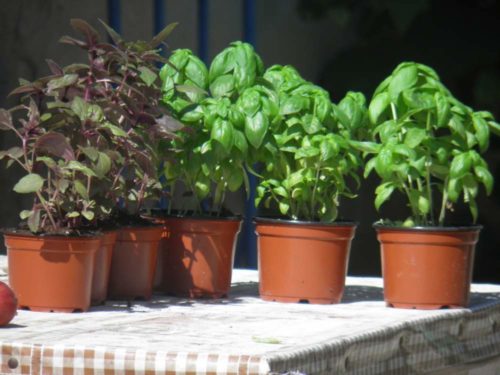
Basil seeds are different long germination... To speed up the process, keep the seed in a warm place for 10-14 days, then soak in warm water for a day. Throw away the floating instances.
- Make holes in the soil and plant the seeds about 3 cm apart. It is unnecessary to do large intervals, since not all crops will sprout.
- Make a polyethylene greenhouse to accelerate germination. The plant loves light and warmth - provide a temperature of 25 ° C.
- Moisten the mini-bed as it dries.
- When the basil rises, thin out the excess so that there is 5 cm of free space around each plant.
- Place on a well-lit windowsill and regularly look after the plantings - water, turn, fertilize, loosen the soil. Heat water for irrigation to 30 ° С.
- Basil loves light, so be sure to install a backlight lamp on the windowsill and provide at least 15 hours of daylight.
For culinary purposes pick off the leaves from the tops of the bush... This will prevent blooming, which makes the grass unfit for food.
Ideal salad variety for home growing
If you are planning to plant greens on the windowsill for the first time, pay attention to watercress. This is one of the most unpretentious and fastest growing plants. Watercress seeds do not require long soaking, and seedlings are resistant to temperature fluctuations and light.The best varieties: Pepper, Ordinary, Broadleaf, Curly.
- To get a bountiful harvest, soak watercress seeds in a mild potassium permanganate solution for a couple of hours.
- Make good drainage at the bottom of the pot and fill it with flower soil from a bag or a mixture of two parts coconut fiber and one vermicompost.
- Prepare holes 5-10 mm deep, sow basil and sprinkle with soil. Moisten and cover with plastic wrap.
- The first micro-greens on the windowsill will appear in a week. Keep the pot at 17-20 degrees.
- The higher the temperature, the more watering should be.
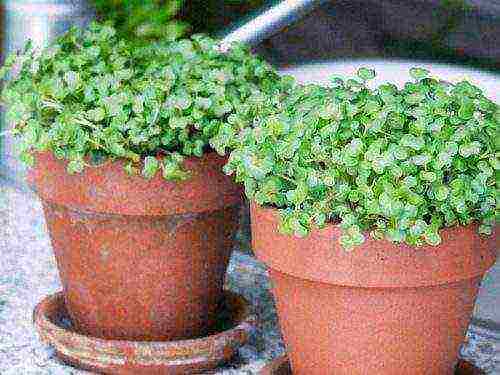
Watercress is one of the most unpretentious plants, it can be grown without land at all. Someone does it right in the water, and someone on foam rubber. But in a pot on the kitchen windowsill, greens look more attractive.
How to get green onions quickly in winter
To grow onion greens at home on the windowsill, you can use two options - in the soil in a pot and in water. The second method is distinguished by its high speed and is well known to everyone from childhood. You just need to fill the glasses with water and place the bulbs in them. Better to take those that have already begun to germinate.
Nuances of growing luka in the water:
- The water should be warm - about 40 degrees.
- If the bulb has not yet begun to germinate, it is recommended to cut the top by 1.5 cm.
- Only the roots should be in the water; the bulb should not be immersed more than one third.
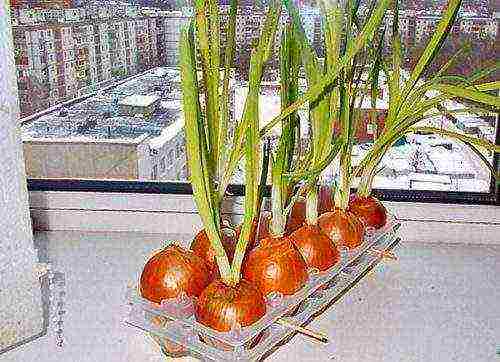
By the way, in the same way, you can grow an avocado from a stone at home and get a beautiful tree.
Instead of jars, it is convenient to use egg packs or special pots for growing onions at home. This is a container with holes for the bulbs. Looks neat and beautiful on the windowsill.
Growing green onions in soil is longer and more difficult. Use bulbs for planting, as the harvest from the seeds may not wait at all.
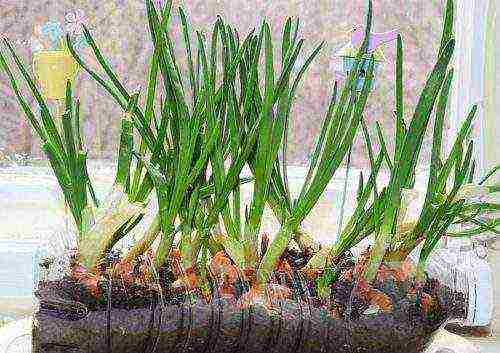
See the video for planting bulbs on greens in a bottle.
Fragrant mint in the home kitchen
An excellent choice for home - mint with a wonderful aroma. Mint is a perennial plant that can be easily grown on a windowsill using root cuttings or seeds. The second method will take more time, but it will also bring more pleasure.
For growing mint, peat or loose humus soil with an acidity of no more than 5-6 pH is suitable. Feel free to buy a universal primer in the store and do not worry. The ideal temperature is 18-25 degrees. Plant good lighting required.
- You need to divide the bush in the fall after the completion of the growing season. Divide the rhizomes carefully so that each portion contains dormant buds.
- Fill the pots two-thirds full with nutrient soil.
- Spread out the seedlings carefully and cover them with soil.
- Drizzle with warm water.
The first leaves should appear in about two weeks.

If you bought a bunch of fresh mint, then try to get planting material using the method cuttings... Simply place a few twigs in the water by dipping them into a root stimulator (root). The roots will appear in 8-14 days. All that remains is to plant the seedlings in pots.
- Sowing mint seeds for growing on a windowsill is best in mid-spring.
- Fill the pot with soil, prepare the wells 0.5 cm deep and moisten the soil.
- Sow the seeds and sprinkle on top with a little of the same soil.
- Cover with a plastic greenhouse.
- At a temperature of 19-25 degrees, seedlings will appear a couple of weeks after sowing.
- Control the moisture content of the ground, avoid drying out and excessive moisture. Water using a spray method to avoid diluting your crops.
When growing mint in winter, do not over-water it. Let the soil dry slightly. Avoid drafts. Water liberally in summer, but protect fresh greens from excess direct sunlight. If conditions permit, use mint to create a fragrant atmosphere in the garden on the balcony.
What else can be grown on a windowsill in an apartment
If you are going to grow greens on the windowsill in winter, you can choose almost any type of fast growing spicy herbaceous plants. Oregano and sage celebrate themselves well in the apartment, they are not demanding of light and withstand partial shade.
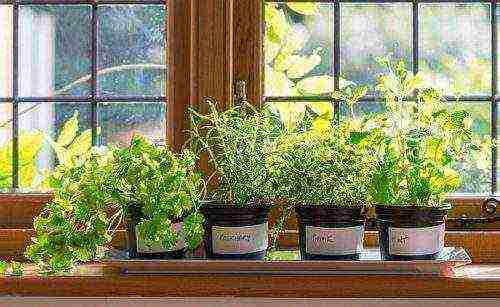
Unpretentious fragrant melissa... Lemon balm seeds just need to be sown into the soil to a depth of 0.5 cm without presoaking, watered and moistened regularly. The greens will hatch in days. Melissa loves light, a lack of it reduces the production of essential oils that impart fragrance to the leaves.
It will require care, but it looks very original on the window celery... The easiest way to get celery greens is in water. Just cut the root off the stem and leave it in a container of water in a sunny place. In a few days, new shoots and roots will appear. You can transplant the plant into soil or leave it in water. Cut green leaves as needed and groom if transplanted.
Green seeds cost a penny. Try, experiment with different types and planting options. Create your own spicy mini-garden to delight yourself and the envy of passers-by looking in the windows. And for more effect decorate the pots with your own handsusing our selection of ideas. So you will be able to significantly save on the purchase of containers.
Having made it your hobby to grow herbs on the windowsill at home, you will enjoy, decorate the kitchen and always have spicy herbs on hand for salads and soups. This hobby is ideal for joint leisure activities with children and husband. Have a good harvest all year round!
Add this page to your favorites and share interesting information with your friends on social networks!


